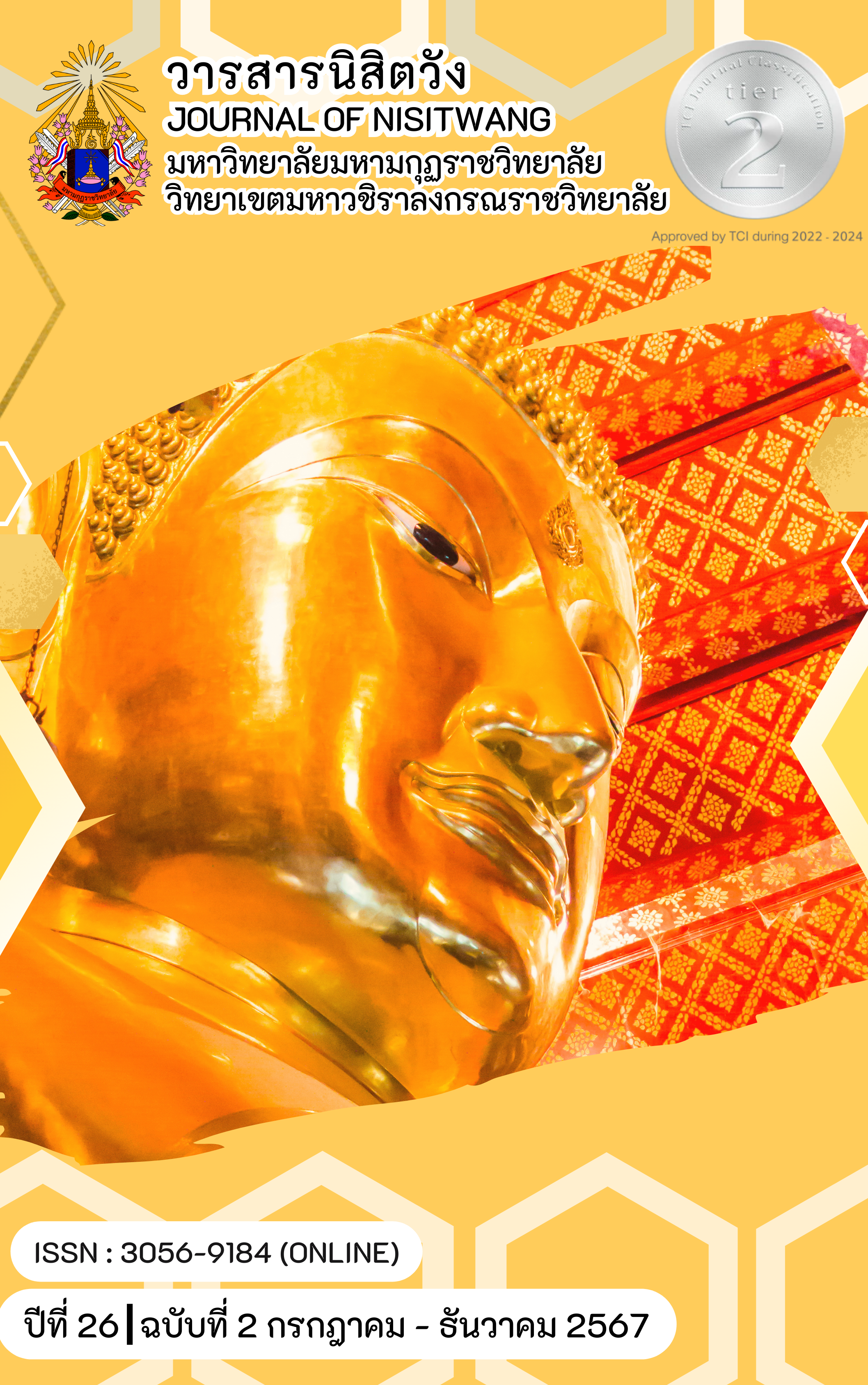DEVELOPMENT OF ACADEMIC ACHIEVEMENT IN SUBJECT GROUPS : SOCIAL STUDIES, RELIGION AND CULTURE IN THE TOPIC OF BASIC ECONOMICS THROUGH CIPPA LEARNING MANAGEMENT FOR PRATHOMSUKSA 3 STUDENTS AT BAN THA MUANG SCHOOL
Main Article Content
Abstract
This research uses a research and development process with the objectives to (1) develop academic achievement in the social studies, religion and culture learning subject group on the subject of basic economics by organizing CIPPA learning of Prathomsuksa 3, to meet the specified criteria of 70 percent, (2) study the academic progress of the social studies, religion and culture learning group on the subject of basic economics by organizing CIPPA learning of students Prathomsuksa 3, (3) study the satisfaction of students in Prathomsuksa 3 with learning about basic economics by organizing CIPPA learning, This research process has seven steps : 1) reviewing previous knowledge; 2) seeking new knowledge; 3) studying and understanding new information and knowledge and connecting new knowledge with previous knowledge; 4) conducting research. Exchange knowledge and understanding with the group, 5) the summarizing and organizing knowledge step; 6) the displaying work step; and 7) the knowledge application step. The population is 31 Prathomsuksa 3 students at Ban Tha Muang School. The tools used in research, consisting of content and learning activities in the Social Studies, Religion, and Culture subject group on the subject of basic economics, Learning management plan, Learning achievement test, Questionnaire on student satisfaction with teaching and learning using the CIPPA learning management method. Statistics used in data analysis include percentage, mean, and standard deviation.
The research results found that :
- Academic achievement in the Social Studies, Religion, and Culture subject group on basic economicsby organizing CIPPA learningof the Prathomsuksa 3 students at Ban Tha Muang School, it was found that the students had an overall average score of 22.23 ( = 22.23), or 74.11 percent, which is higher than the 70 percent threshold.
- Learning progress in the Social Studies, Religion and Culture subject group : basic economics by organizing CIPPA learning of students in Grade 3 at Ban Tha Muang School. It was found that the learning progress value using the Normalized Gain method was 0.57(<g > = 0.57), which was at a moderate level or equivalent to 57 percent, which is in line with the assumptions set.
- Satisfaction of Prathomsuksa 3 students at Ban Tha Muang School that has an impact on learning the social studies, religion and culture learning group on the subject of basic economics by organizing CIPPA learning overall, it was at a high level (μ= 4.33, standard deviation σ= 0.67).
Article Details
References
กระทรวงศึกษาธิการ. (2545). พระราชบัญญัติการศึกษาแห่งชาติ พ.ศ.2542 และที่แก้ไขเพิ่มเติม(ฉบับที่ 2)
พ.ศ.2545 พร้อมกฎกระทรวงที่เกี่ยวข้องและพระราชบัญญัติการศึกษา ภาคบังคับ พ.ศ. 2545. กรุงเทพฯ : องค์การรับส่งสินค้าและพัสดุภัณฑ์.
งามตา ทุ่งยอ และคณะ. (2565). การพัฒนาผลสัมฤทธิ์ทางการเรียนวิชาสังคมศึกษา ศาสนาและวัฒนธรรม เรื่อง อุปสงค์และอุปทาน โดยใช้หลักการจัดการเรียนรู้แบบโมเดลซิปปา สำหรับนักเรียนชั้นมัธยมศึกษาปีที่ 1/3 โรงเรียนหาดใหญ่พิทยาคม อำเภอหาดใหญ่ จังหวัดสงขลา. ใน การประชุมหาดใหญ่วิชาการระดับชาติ
และนานาชาติ ครั้งที่ 13 วันพฤหัสบดีที่ 12 พฤษภาคม 2565 (หน้า 2085-2096) สงขลา : มหาวิทยาลัยหาดใหญ่.
ทิศนา แขมมณี. (2542). การจัดการเรียนการสอนโดยยึดผู้เรียนเป็นศูนย์กลาง : โมเดลซิปปา (CIPPA MODEL).วารสารวิชาการ กรมวิชาการ, 2 (5), 4-13.
บุญชม ศรีสะอาด. (2560). การวิจัยเบื้องต้น. กรุงเทพฯ : สุวีริยายสาส์น.
ไพรจิตร บ้านเหล่า. (2560). การพัฒนาการเรียนการสอนที่เน้นผู้เรียนเป็นสำคัญรายวิชา ส 32103 สังคมศึกษา ชั้นมัธยมศึกษาปีที่ 5 เรื่อง สถาบันทางสังคม โดยใช้รูปแบบการสอนแบบซิปปา (CIPPA Model).
โรงเรียนโคกโพธิ์ไชยศึกษา จังหวัดขอนแก่น สำนักงานเขตพื้นที่การศึกษามัธยมศึกษา เขต 25.
สำลี รักสุทธี. (2554). เทคนิควิธีการจัดการเรียนการสอนและเขียนแผนการสอนโดยยึดผู้เรียนเป็นสำคัญ.
กรุงเทพฯ : พัฒนาศึกษา.โรงเรียนบ้านท่าม่วง. (2563). การประเมินผลสัมฤทธิ์ทางการเรียนปีการศึกษา 2561-2565. สุราษฎร์ธานี : โรงเรียนบ้านท่าม่วง.
เรณู ครึกครื้น. (2563). ผลการพัฒนาผลสัมฤทธิ์ทางการเรียน กลุ่มสาระการเรียนรู้สังคมศึกษา ศาสนา และ
วัฒนธรรม (สาระที่ 3 เศรษฐศาสตร์) โดยใช้เอกสารประกอบการเรียน เรื่อง เศรษฐศาสตร์กับชีวิต ชั้นประถมศึกษาปีที่ 5. วารสารวิชาการ มหาวิทยาลัยรัาชภฏเพชรบุรี, 10 (3), 45-55.
วราภรณ์ ประจงเศรษฐ์ และคณะ. (2562) การเปรียบเทียบผลสัมฤทธิ์ทางการเรียน สาระเศรษฐศาสตร์ ระหว่างการจัดการเรียนรู้แบบซิปปาโมเดลกับการจัดการเรียนรู้แบบปกติของนักเรียนชั้นประถมศึกษาปีที่ 3. วารสารอิเล็กทรอนิกส์ สื่อนวัตกรรมและการศึกษาเชิงสร้างสรรค์, 2 (1), 23-35.วรารัตน์ กลมคุณากร และลัดดา 9.ศิลาน้อย. (2556). การพัฒนากิจกรรมการเรียนการสอนและผลสัมฤทธิ์ทางการเรียนกลุ่มสาระการเรียนรู้สังคมศึกษา ศาสนา และวัฒนธรรม สาระภูมิศาสตร์ ชั้นประถมศึกษาป.ที่ 5 โดยใช้รูปแบบซิปปา (CIPPA Model). วารสารศึกษาศาสตร์ ฉบับวิจัยบัณฑิตศึกษา มหาวิทยาลัยขอนแก่น, 7 (2), 148-156.
อรทัย มูลคํา. (2553). 21 วิธีจัดการเรียนรู้ : เพื่อพัฒนากระบวนการคิด. พิมพ์ครั้งที่ 8. กรุงเทพฯ : ภาพพิมพ์.เอธัส ศิลารักษ์ และจิฑาภรณ์ อินทร์แย้ม. (2563). การพัฒนาผลสัมฤทธิ์ทางการเรียนรายวิชา สังคมศึกษาศาสนาและวัฒนธรรม สาระเศรษฐศาสตร์ ของนักเรียนชั้นประถมศึกษาปีที่ 6 โดยใช้การเรียนรู้
แบบร่วมมือเทคนิคซิปปา. วารสารครุศาสตร์ มหาวิทยาลัยราชภัฏนครสวรรค์, 3 (3), 57-67.
Jason A. Orozco and Rosanelia T. Yangco. (2016). Problem-Based Learning : Effects on Critical and Creative Thinking Skills in Biology. Philippine Normal University, The Asian Journal of BiologyEducation, 9, 2-10.

